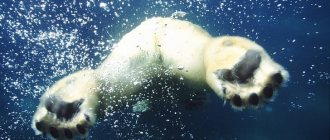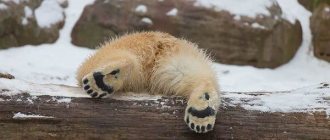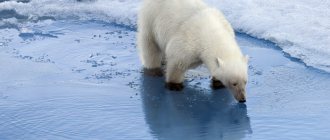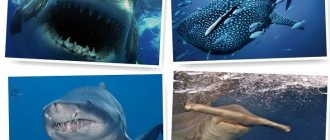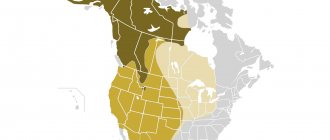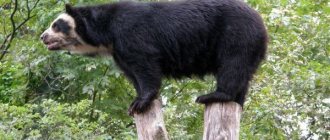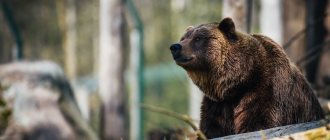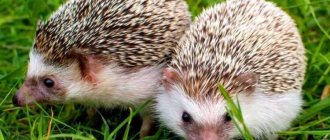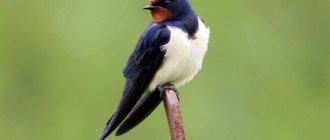Currently, the largest mammal on our planet is the polar bear.
It is also called white. This predatory animal is a relative of the brown bear.
Origin of the species and description
Photo: Polar bear
According to recent studies, scientists have concluded that the polar bear as a species appeared quite recently through rapid evolution. The age of the species is estimated at only 150 thousand years. Although you cannot completely rely on this information, collecting the genetic material of a given animal has its own difficulties. It is very rare to find remains in the ice; perhaps much about these animals is still preserved there.
So, the polar bear belongs to the class of mammals, order of predators, suborder of canids, family of bears, genus of bears. It is also called a polar bear, less often a northern or sea bear. It is believed that polar bears evolved from brown bears during evolution and adaptation to the northern polar latitudes.
Video: Polar bear
Already in this century, evidence of the existence of an intermediate species was discovered - a giant polar bear, its bones are one and a half times larger than those of a modern one, the finds are limited to a few bones. The DNA of this species is similar to that of both the brown bear and the modern white bear. Therefore, it can be considered an intermediate link in evolution.
The diversity of species during evolution is excluded; animals are very limited by living conditions and type of nutrition. This is one of the most powerful and dangerous predators. Its body is very massive: it reaches 3 meters in length and up to 1.5 meters at the withers. The weight of such an animal is very large: for the largest males it is 800 - 1000 kg, females are much smaller and the largest of them weigh almost 400 kg.
Passionate opera singer
Competition founders Paul Joynson-Hicks and Tom Sullam discovered that funny animal photographs could also be used to campaign for conservation. Joynson-Hicks has been photographing wild animals for many years. During this time, he took many photographs that made him laugh out loud. This is how the idea of the competition was born. This passionately singing hamadryas was photographed by photographer Clément Guinard in Saudi Arabia.
The funniest animal photos of 2022
Appearance and features
Photo: Animal polar bear
Polar bears are large, heavy animals. The head, in comparison with the body, is small, elongated, slightly flattened. The eyes are round, set closer to the nose. The relief of the skull is clearly visible above the eyes; here the bear has the thinnest fat layer. The ears are short, rounded, and small. The nose is elongated, similar to a dog. The polar bear's neck differs from other species in length; it is extended forward and is quite thin near the head. Below the neck widens, passes into the body. It is very large in a bear; additional volume is created by thick, long, coarse hair and undercoat.
Its paws are especially powerful. With one blow, a bear can kill its prey, if it is not large in size. Surprisingly, despite the weight of his limbs, he is very agile and runs fast. Watching a polar bear from the side, you can even call it graceful and graceful. Bears have membranes between the toes on their front paws; they help them make powerful strokes; with their help, the animals swim excellently. The body ends in a small white tail.
Polar bears are adapted to live in incredible cold, among ice and snow, and swim in cold waters. Nature has provided them with a thick layer of fat, reaching 13 cm.
Bears have thick, black skin, which is clearly visible on their paws, and, as it turns out, there is fur on their soles. This allows bears to move boldly and not slip on the ice. And the most obvious thing is the fur, it is dense, tough, two-layered, thick - it also protects the bear from the harsh climate.
Do not make me laugh!
The Comedy Wildlife Photography Awards have been awarded since 2015. During this time it has grown into a world-famous event. “This gray seal pup swam onto a rocky beach in North Yorkshire and slept on a rock for several hours,” says photographer Martina Novotná. “Periodically, he would stretch and yawn, and suddenly an expression appeared on his face as if he was giggling.”
The funniest animal photos of 2022
Where does the polar bear live?
Photo: Polar bear Red Book
The bear is accustomed to cold, it is thanks to it that this species appeared, and life in such conditions suits it. There must be an ocean near the habitat. Bears do not go far towards land, but they can calmly swim on ice floes. Surprisingly, these animals can swim even a hundred kilometers from the shore.
The record distance for which a bear swam from the shore was recorded as 600 km. In the water, of course, they hope to catch their prey. That is why they are sometimes called marine.
The maximum number of individuals live on the coast of the Arctic Ocean. These northern bears inhabit the coldest islands in the world, for example, the islands of Canada and Greenland, the islands of all the northern seas washing Eurasia, namely the Barents Sea, the Chukchi Sea, the East Siberian Sea, the Okhotsk Sea and the Kara Sea, the Laptev Sea and the Beaufort Sea. The southernmost habitats of polar bears are Alaska and the coast of Norway. There are often cases when, during hungry days, bears come close to infrastructure in search of food; this is often written about in the news.
In captivity, bears are kept in enclosures with a large swimming pool. They need water constantly, especially in summer. In the heat of the zoo, you can often watch a polar bear jump into the water, swim, play in it, and come out onto land only to plop down again.
Now get into the water, baby!
This year, 42 photographs made it to the finals of the competition. Anyone can vote for their favorite on the Comedy Wildlife Photo Award website. For example, for this photo in which an otter teaches its cub to swim, without much ceremony with it. Photographer Chee Kee Teo captures this stern parenting style in Singapore.
The funniest animal photos of 2022
What does a polar bear eat?
Photo: Northern polar bear
Polar bears are the largest predators and require large amounts of food. Due to the harsh climatic conditions in which they live, the diet of these animals is extremely limited - after all, among the victims of a bear there can only be those animals that live in the same conditions, and there are not many of them and they are found mainly in water.
The main food for bears can be listed on one hand:
- Harp seal;
- Ringed seal;
- sea hares;
- Young walruses;
- Narwhals;
- Beluga whales;
- Fish;
- Carrion;
- Bird eggs.
They hunt mammals on ice floes, watch outside, and then suppress prey, or plunge their heads into the water and grab them with their teeth. The most preferred, of course, are seals and seals. When eating an animal, they first absorb the skin and subcutaneous fat, and the rest according to their appetite. On average, up to 10 kg of food is enough for them to satisfy their hunger. But if a bear is after long wanderings or hibernation, then it is ready to eat everything and completely, capable of absorbing as much as 20 kg of food.
In summer, bears have difficulty finding food in some areas due to the melting and retreat of the glaciers from which they hunt. This forces them to go inland in search of bird nests, small animals, or even cesspools and landfills.
It happens that bears go through a hunger strike. The longest can last up to four months. But animals are ready for this, their fat reserves serve not only as heating, but also as a source of nutrients for the hungry period.
Boo!
A prairie dog in the US state of Colorado managed to stun an attacking bald eagle so that the bird was briefly distracted. Whether the prairie dog managed to escape to its den is unknown. Arthur Trevino captured only this scene.
The funniest animal photos of 2022
Features of character and lifestyle
Photo: Big polar bear
The two main needs of polar bears are food and sleep. And this is not surprising in such a cold climate. The animal spends a lot of time on the ice, hunting and eating its victims. Hunting is their life. They wander along the shore, looking for young walruses. Having discovered a small individual, the bear carefully creeps up to it. The white color helps a lot here; it camouflages the bear against the background of snow. Once ten meters from the target, the bear makes a sharp jump towards its prey. But adult walruses are still too tough for them, and in the water they can even engage in combat.
After the meal, the bear can sleep for several hours, after which it goes hunting again. This is necessary in order to stock up on fat, because even the Arctic Ocean has its hardships. Surprisingly, this is a thaw, all the ice moves away from the shores, this makes it impossible for the bear to hunt and forces it to look for meager food on land.
For males and non-pregnant females, life is as follows: hunting and sleeping alternate. They can hibernate during the winter, but this is not necessary. And even if a bear lies down in a den, it won’t last long. Sleep can last from one month to three, and then hunting again.
Pregnant females necessarily hibernate, and for a long period, from October to April. The average lifespan of a polar bear in the wild is 20 - 30 years. Polar bears are accustomed to a life devoid of excesses. All living creatures living nearby are potential food. Therefore, the beast can attack both humans and dogs.
Bear hunters have long noted the extraordinary attachment of mothers to offspring in these animals. Several cases have been recorded when a female bear remains howling and licking killed cubs, ignoring the impending danger to herself. Manifestations of strong aggression towards murderers are also known.
Looks like summer is over
While photographer John Speirs was photographing pigeons in flight on the west coast of Scotland, the wind blew a dry leaf over the head of one of the birds. The idea is clear: summer is over, autumn is on the doorstep.
The funniest animal photos of 2022
Social structure and reproduction
Photo: Polar bear cubs
Polar bears are loners by nature, both males and females. They may roam and hunt close to each other, but do not interact much. When the mating season begins for animals, which is spring, March - June, males can follow females and engage in fights with other males. Each mature female may be accompanied by several mature males. She mates with one, the winner.
Pregnancy lasts about eight months. During this time, the females manage to organize a den for themselves and hibernate. By spring, from one to three cubs are born, but most often there are two. The weight of one baby is less than a kilogram, and there is no hair. In twenty percent of cases, babies die. Until a month old, the cubs are completely blind, they develop very slowly and need maternal warmth and care. The lactation period for polar bears lasts up to one and a half years. Even up to two years old, the cubs can remain with their mother, then they begin to lead a solitary life.
Females become sexually mature at four years of age, but sometimes they can give birth to their first offspring as early as eight years of age. Males reach maturity at around five years of age or even later. A mother bear devotes a total of three years to pregnancy and breastfeeding. This is the most successful option when females give birth once every three years. But in nature, of course, difficulties regularly occur and females become pregnant less often. Therefore, it is quite difficult to increase the number of polar bears.
Put the camera away or you'll be in trouble!
The competition has different categories, including for flying, land and sea animals. But even if a squirrel flies through the air, it is still a land animal. But this chameleon in the Western Ghats in India clearly shows the photographer that he is not in the mood for a photo shoot right now.
The funniest animal photos of 2022
Natural enemies of polar bears
Photo: Siberian polar bear
Among the inhabitants of the north, the polar bear does not have many enemies. There are very few people there who can cope with an adult. However, it happens that while swimming and diving, while the bear is hunting, it can be attacked by adult walruses with huge tusks, and sometimes killer whales, large sea predators, attack it.
Speaking about the enemies of polar bears, it is rather worth noting how dangerous it can be for their cubs. They are so helpless that if they find themselves at a distance from their mother, they can easily become prey for all land predators:
- Volkov;
- Pestsov;
- Dogs;
- Birds of prey.
If the mother is noticed or goes off to get prey, the cubs are immediately in danger; unreasonable and stupid, they themselves can rush towards death. Even though they are officially protected, bears often become victims of poachers. Man was, is and remains the main enemy of polar bears.
What a beautiful day!
This photo of a cheerful blue dragonfly was taken in a nature reserve in western Germany. Axel Bocker's photo was selected from 7,000 submitted to the competition. “It's an amazing turnout, especially considering it was filmed during a pandemic,” says Joynson-Hicks. And no wonder, he adds, because “the wildlife is really amazing and fun.”
The funniest animal photos of 2022
Population and species status
Photo: Polar bear from the Red Book
The total number of polar bears is, according to the latest data, 20 - 25 thousand individuals. However, scientists predict a reduction in numbers by a third by 2050.
Geographically, there are three populations of polar bears:
- Chukotka-Alaska;
- Kara-Barents Sea;
- Laptevskaya.
In Russia, polar bears are listed in the Red Book, under the status of a vulnerable species. The increase in the number of polar bears is questionable: they are reproducing slowly, and the death toll is not falling. Despite the ban on shooting bears, many become victims of poachers for the sake of their skins and even just the thrill of the hunt. Moreover, the physical condition of the animals is deteriorating.
Scientists predict warming, which does not bode well for this species. As the ice melts, bears are deprived of their main habitat and hunting, starve and die ahead of schedule, without even having time to leave offspring. Over the past decades, the ecology of the habitat has deteriorated, which also affects the population size and shortens the lifespan of individuals.
Habitat
Polar bears live in the ice of the circumpolar Arctic. There are about 20 populations, which hardly mix with each other and vary greatly in number - from 200 to several thousand individuals. The size of the entire world population is approximately 22-27 thousand animals.
The permanent residence of polar bears is the coastal ice of continents and islands, where the number of their main prey - ringed seals - is quite high. Some individuals live among less productive multi-year ice in the central Arctic region. From the south, their distribution is limited to the southern limit of the seasonal ice cover in the Bering and Barents Seas and in the Labrador Strait. In areas where the ice melts completely in the summer (Hudson Bay and southeast Baffin Island), animals spend several months on the shore, using up their fat reserves, until the water freezes.
Just don't make any noise, I have a headache
Anita Ross photographed this baby jackrabbit owl in California. He looked so listless, like after a hangover, she laughs. The organizers of the Comedy Wildlife Photo Award showcase the beauty of nature and call for its protection on their website. Eat less meat, fight deforestation, don't buy plastic products, they say.
